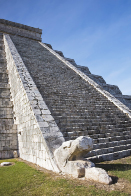Module 7
1. Module 7
1.10. Page 5
Module 7: Trigonometry
Lesson 2 Summary

© David Davis/shutterstock
This photograph is of the head of the feathered serpent at the foot of the Temple of Kukulkan, at the Mayan city of Chichen-Itza, Mexico. Because of the careful design of this monument, during the spring and fall equinoxes the shadow cast by the stone ramp along the stairs becomes the body of the serpent moving up and down the stairs.
The slope necessary to produce this effect is a reminder of the skill of the Mayan architects, stone masons, and artisans. The mathematics of the Mayans was also responsible for an accurate calendar.
In this lesson, you explored this question:
How is the tangent ratio used to solve a variety of practical problems?
Check your level of understanding of the materials covered in this lesson by completing “Lesson 2 Traffic Lights.” If you select an amber or red traffic light in the multimedia piece, you will receive information about additional work you can complete to improve your understanding of the topics. Complete the suggested work before you proceed to the Lesson 2 Assignment. If you experience difficulty, contact your teacher before starting the Lesson 2 Assignment.
To answer this question, you reviewed the definition of the tangent as the ratio of the side opposite to the side adjacent for a given acute angle in a right triangle. You used this ratio to find missing sides and missing angles in a variety of practical problems.
 Assignment
Assignment
Retrieve the Lesson 2 Assignment Booklet you saved in your course folder at the start of this lesson. Complete the Assignment.
Resave your Assignment Booklet in your course folder and submit a copy to your teacher for assessment.
Unit 3 Project
Before you move on to Lesson 3, you should take a look at your Unit 3 Project topic. Look for right triangles and places where the tangent ratio could help you find a length measurement or angle measurement. Make sure you keep any sketches and calculations in your course folder for use in your presentation. For more information about this step and later steps, refer to the Unit 3 Project.